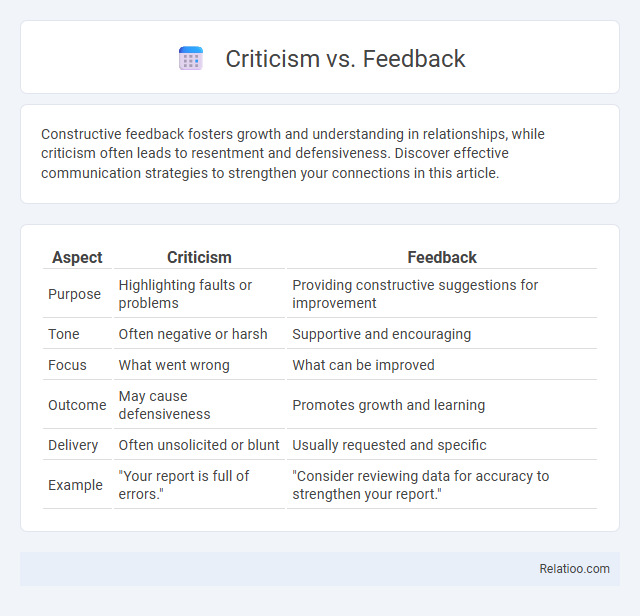Constructive feedback fosters growth and understanding in relationships, while criticism often leads to resentment and defensiveness. Discover effective communication strategies to strengthen your connections in this article.
Table of Comparison
| Aspect | Criticism | Feedback |
|---|---|---|
| Purpose | Highlighting faults or problems | Providing constructive suggestions for improvement |
| Tone | Often negative or harsh | Supportive and encouraging |
| Focus | What went wrong | What can be improved |
| Outcome | May cause defensiveness | Promotes growth and learning |
| Delivery | Often unsolicited or blunt | Usually requested and specific |
| Example | "Your report is full of errors." | "Consider reviewing data for accuracy to strengthen your report." |
Understanding Criticism and Feedback
Understanding criticism involves recognizing it as evaluative comments that highlight perceived faults or shortcomings, often emphasizing negative aspects. Feedback, however, is a balanced response aimed at helping improve performance or outcomes by addressing strengths and areas for growth constructively. Distinguishing between criticism and feedback is crucial for effective communication, as feedback fosters development whereas criticism may lead to defensiveness or demotivation.
Key Differences Between Criticism and Feedback
Criticism often highlights faults or mistakes in a negative manner, focusing on what is wrong, whereas feedback provides constructive information aimed at improvement and growth. Feedback is specific, actionable, and balanced, helping recipients understand both strengths and areas for development, while criticism can be vague and discouraging. Disagreement differs as it involves a difference in opinion or perspective without necessarily addressing the quality or effectiveness of an action or behavior.
The Impact of Criticism on Personal Growth
Criticism, when constructive, fuels personal growth by highlighting areas for improvement and fostering self-awareness. Unlike feedback, which is typically neutral and informative, criticism often carries emotional weight that can either motivate or discourage You depending on delivery and mindset. Embracing criticism as an opportunity rather than a threat cultivates resilience and accelerates your development.
The Role of Feedback in Performance Improvement
Feedback serves as a crucial tool in performance improvement by providing clear, constructive, and actionable insights that help you identify strengths and areas for growth. Unlike criticism, which can be judgmental and demotivating, effective feedback focuses on specific behaviors and outcomes to guide learning and development. Disagreement may arise during the feedback process, but when handled respectfully, it fosters open communication and innovative problem-solving, ultimately enhancing performance.
Constructive Criticism vs Destructive Criticism
Constructive criticism offers specific, actionable insights aimed at improvement, fostering growth and positive change in performance or behavior. Destructive criticism, by contrast, often targets personal traits or mistakes without providing solutions, leading to demotivation and decreased confidence. Understanding this distinction clarifies how effective feedback promotes collaboration, while negative comments may hinder progress and strain relationships.
Techniques for Giving Effective Feedback
Effective feedback techniques emphasize specificity, focusing on observable behaviors rather than personal traits to enhance understanding and improvement. Use clear, constructive language that encourages dialogue and active listening, ensuring your feedback is balanced with positive observations to maintain motivation. Tailoring your approach to the recipient's communication style helps you deliver impactful feedback that fosters growth and resolves disagreements productively.
Common Misconceptions About Criticism and Feedback
Criticism and feedback are often confused, yet criticism tends to focus on pointing out faults, while feedback aims to provide constructive insights for improvement. Many people mistakenly equate all negative comments with criticism, overlooking that feedback can be supportive and growth-oriented. Understanding this distinction helps you receive and respond to input more effectively, enhancing personal and professional development.
How to Receive Criticism and Feedback Positively
Receiving criticism and feedback positively involves viewing them as opportunities for growth rather than personal attacks. Focusing on specific points and asking clarifying questions can help distinguish helpful insights from subjective opinions or disagreements. Maintaining an open mindset and practicing active listening fosters improvement and resilience in both professional and personal settings.
Creating a Culture of Open Feedback
Creating a culture of open feedback requires distinguishing criticism, feedback, and disagreement by emphasizing constructive communication and mutual respect. Feedback is focused on specific behaviors and outcomes, promoting growth, while criticism often highlights faults without actionable guidance. Disagreement involves differing perspectives that, when managed respectfully, can foster innovation and deeper understanding within teams.
Moving From Criticism to Constructive Feedback
Moving from criticism to constructive feedback involves shifting the focus from personal attacks to specific, actionable suggestions that drive improvement. By clearly addressing behaviors or outcomes rather than character, you create a supportive environment that encourages growth and collaboration. Your ability to communicate feedback constructively transforms potential conflicts into opportunities for positive change and shared understanding.

Infographic: Criticism vs Feedback
 relatioo.com
relatioo.com